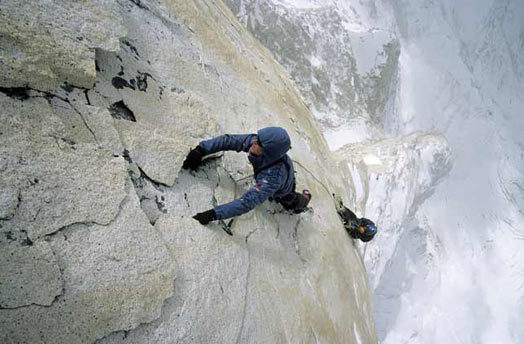
Stephan Siegrist and Denis Burdet reenacting the climbing on the new route, Harvest Moon (VI 6a WI5 A3 M6, 1500m), on the north face of Thalay Sagar. Garhwal Himalaya, India. [Photo] Rob Frost
In September, Denis Burdet, Thomas Senf, Ralph Weber and I, accompanied by the young Croatian photographer Zvonimir Pisonic and the American Rob Frost (who filmed the expedition), traveled to the north face of Thalay Sagar. Since Zvonimir spoke Croatian; Rob, English; Denis, French; and the rest of us, German, we had a team reminiscent of the Tower of Babel: six people and five different languages.
Our goal was the northwest pillar on the right side of the north face. A Spanish expedition first tried the pillar in 1987; since then it has been left alone. It was time to harvest this relatively safe line.
Five days after leaving Delhi, we reached advanced base camp at 5300 meters in beautiful weather. In teams of two, we began fixing an endless ice field. We found a perfect spot for our small single-wall tent under a stable ice roof at the base of the first pillar at 5800 meters. The next day Denis and I climbed the first meters of the shadowed wall. This side of the pillar seemed to be the actual north side of the mountain, never warmed by the slightest sunbeam. The cracks were filled with ice and the steep terrain didn’t allow us to free climb. We could not underestimate the difficulties on this route.
Ralph and Thomas then climbed an ice ramp that crossed the lower buttress at the halfway point. The ramp took more time than we had calculated. The fresh snow from the previous weeks hadn’t consolidated, making climbing the chimney that followed difficult. After traversing a 900-meter ice ramp, we fixed three pitches on the “banana crack,” a granite gap visible from far below. Fortunately a number five Camalot, expanded to the outer edge of its aluminium callipers, served as pro–otherwise we would have had to rename it the crack of horror!
Three steep ice/mixed pitches brought us to the bottom of our key position at 6400 meters, where we set up Camp II. From the distance it had appeared as if there were walkable terrain between the first and second pillars. But appearances were deceiving: the terrain was sixty degrees, and the rock was covered only slightly with snow. We were then surprised by a 120-meter deep, 100-meter wide canyon! Fortunately, we found a small space for our camp only fifty meters farther on. To describe it as luxurious would be a huge exaggeration, but the beautiful view made up for the bad sleep.
At 11 a.m. the first sun rays touched the upper pillar exactly where we had planned our route. The strong winds, which occurred mostly in the mornings, turned climbing in the shade into an ordeal. We had expected some cracks but couldn’t see a single one on the fifty-meter-wide front side of the pillar. Our speed was about that of handicapped snails: the not-very-safe climbing on plates and polished rock made advancing at a faster pace impossible.
The monsoon season brought snow almost every afternoon; some days we advanced only thirty meters. Fortunately, we did not miss the right moment to exit the wall. Thanks to satellite-transmitted text messages from Meteo Suisse, we knew a lot of snow would fall from September 21-23, so we descended to base camp, where the storm crushed four of six tents. We let the snow consolidate for two more days before making our final attempt.
On September 25, all four of us jugged our lines to our high point on the upper pillar. The next day we managed to climb the last meters of the pillar. The weather forecast was good but with a lot of wind. At 4 a.m. the alarm clock rang. The chilly morning temperatures made a fast advance impossible. At 9 a.m. we reached the Original Route, the crux of which, the infamous, brittle “Black Band” that crosses so many mountains in the Garhwal Himalaya, lay ahead of us. We easily mastered this 150-meter headwall, then finally reached the summit. We could hardly believe that only three days before we had been on our way from ABC.
We spent more than an hour on the summit in fantastic weather. This was the day of a full moon, an event celebrated by the Hindu. Although none of us are very religious, it was special for us as well because we had always dreamed of standing on the summit on a full-moon day!
Rob, who had ascended to Camp II, filmed a few sequences on the descent. We named our route Harvest Moon (6a WI5 A3 M6, 1500m).
— Stephan Siegrist, Interlaken, Switzerland